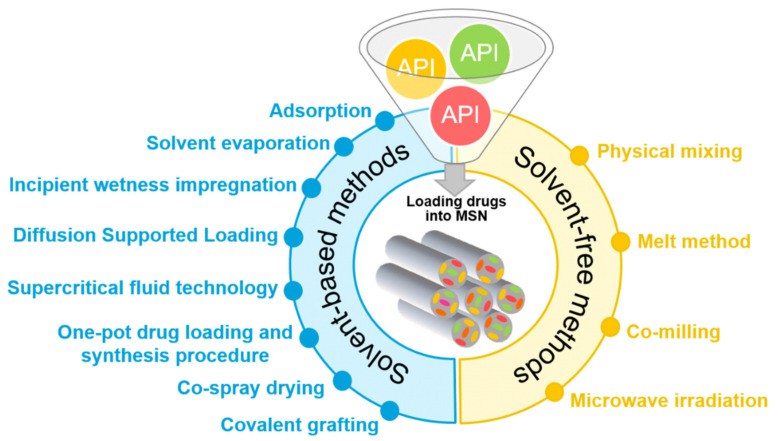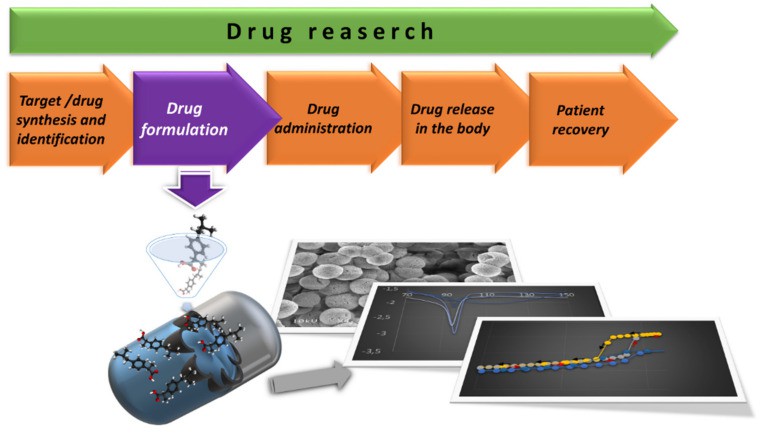Analysis of Systems with Mesoporous Silica Materials
As a drug delivery system (DDS), Mesoporous silica material (MSN) has an ordered porous network with very uniform size, which can well control the drug loading and release kinetics and accommodate the high pore volume of the required number of drugs. MSN has many characteristics, making it very suitable for drug delivery applications. It includes high load capacity, excellent biocompatibility and easy functionalization. The high surface area of MSN means high potential for drug adsorption.
As an expert in the field of nuclear magnetic resonance, Creative Biostructure provides customers with analysis services of the physical and chemical properties of nanoparticles in the API/MSN system and host-guest interaction mechanism based on the solid-state nuclear magnetic resonance (SS NMR) spectrum.
 Figure 1. Schematic breakdown of the different methods used to load drugs into MSN. (Trzeciak et al., 2021)
Figure 1. Schematic breakdown of the different methods used to load drugs into MSN. (Trzeciak et al., 2021)
Our Principles
We have established a system to study the drug-carrier interaction, quantity (loading degree), location, local molecular dynamics and physical state inclusion complex interaction of loaded drugs in the API/MSN system by SS NMR technology.
SSNMR is a non-destructive and highly flexible technology that can determine various parameters. Through different experiments, structural information and dynamic parameters can be obtained during one measurement. Contrary to other technologies, SSNMR can be applied to any solid physical state (crystalline and amorphous) and materials of different complexity,
In our technical system, we are based on the following three technologies:
- Magic Angle Spin (MAS)
- Dynamic nuclear polarization (DNP)
- Surface-enhanced nuclear magnetic resonance spectroscopy (SENS)
SS NMR has become the primary method for us to analyze mesoporous materials and drugs limited in the interaction between nano-carriers and API-MSN.
 Figure 2. A multi-step pathway in the drug research—from synthesis of Active Pharmaceutical Ingredient (API) to patient recovery. (Trzeciak et al., 2021)
Figure 2. A multi-step pathway in the drug research—from synthesis of Active Pharmaceutical Ingredient (API) to patient recovery. (Trzeciak et al., 2021)
Service Content
Our services include but are not limited to:
- Check the structure of encapsulated API molecules.
- Test on the ability of silica-based materials to improve solubility.
- Aging behavior test on silica.
- Analysis of the influence of different functional groups in silica on the interaction between model drug and matrix and the related insertion and delivery rates.
Implementation Methods of Specific Projects
| Case of our service | Our methods |
|---|---|
| Analysis service for local environment and molecular behavior of API embedded in the silica matrix. | 13C MAS single-pulse and cross-polarized NMR spectra, 1H MAS NMR spectra. |
| Detection and cytotoxicity analysis of silica functionalization in API/MSN system. | Standard one-dimensional 13C and 29Si SSNMR spectra. |
| Detection of interaction between drugs and silica. | 1H-13C and 1H-29Si heteronuclear correlation (HETCOR) experiment. |
| Flow analysis of the main drug at different temperatures (such as ambient temperature and low temperature). | 1H, 13C, 29Si multi-core SS NMR. |
| Analysis of loading process and API interaction in the hole. | 1H-13C HSQC High Resolution (HR) MAS. |
Applications of Our Service
- Confirm the safety of MSN as drug delivery carrier.
- Study the size and shape of MSN in drug delivery systems, as well as the loading and release process.
- Understand the physical and chemical properties of nanoparticles and understand the host-guest interaction mechanism.
- Set a theoretical basis for building a new delivery system.
Creative Biostructure is committed to providing high-quality NMR analysis services to advance the life sciences fields. If you have any questions or needs, please contact us and our customer service staff will help you the first time.
Ordering Process
Reference
- Trzeciak K, et al. Mesoporous silica particles as drug delivery systems—The state of the art in loading methods and the recent progress in analytical techniques for monitoring these processes. Pharmaceutics. 2021, 13(7): 950.
